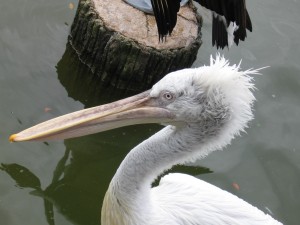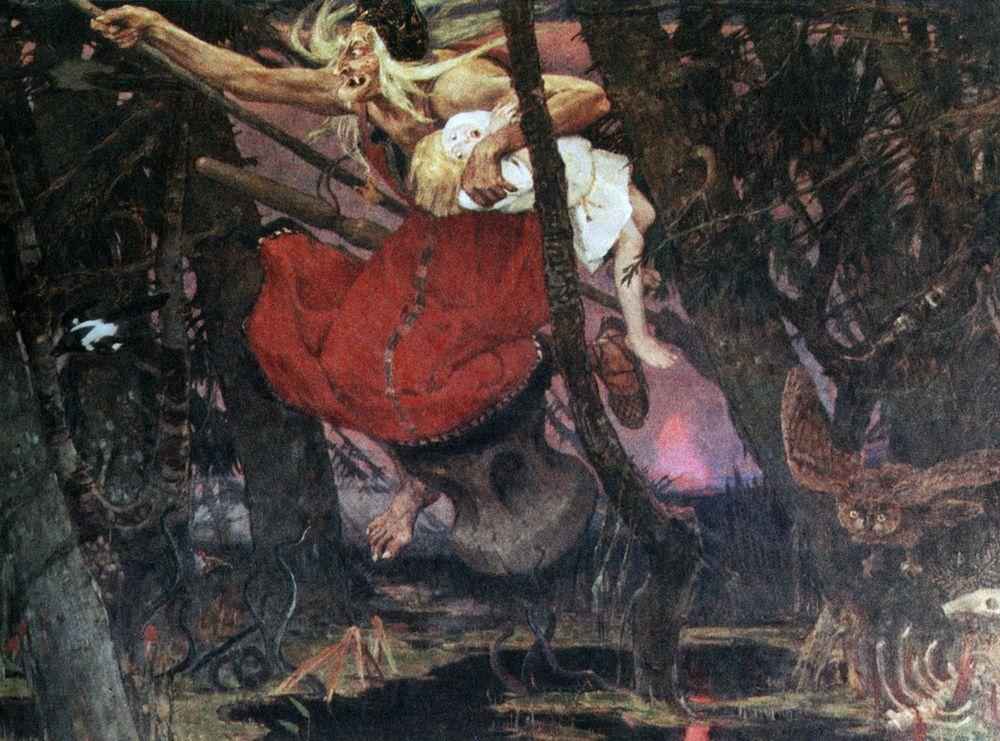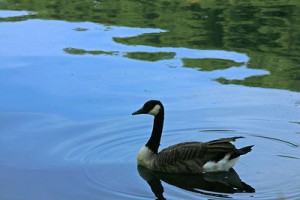
Michael Shapiro (1983) finds that Baba Yaga is derived from two prehistoric theriomorphic prototypes – the snake and the pelican. The Slavic word baba, like other Slavic kinship terms, has been applied to species of plants and animals. Baba has come to be the indigenous term for the pelican in some Russian, Ukrainian, Bulgarian, and Upper Sorbian dialects…
The pelican depends mostly on fresh fish kills for her diet, but she is also a scavenger who has undoubtedly dogged humans since we began fishing. An animal which develops a symbiotic relationship with humans often becomes a divinity. Baba Yaga is depicted today as an old woman, and she parallels the grandmother owl and raven goddesses of northern Europe, who are scavengers or predators like the pelican. Baba Yaga is usually described as having a very long nose, and sometimes a pronounced chin as well, which also evokes the pelican. The pouch of the pelican can be compared to the skin hanging from the jowls of an old woman, and the large body of the pelican is like the sturdy stout figure many women develop as they age.Marija Gimbutas has documented in detail the fondness of Neolithic European cultures for water bird goddesses. While in most cases it is impossible to know what type of water bird is being depicted, it would make sense for the pelican to be represented. Outside of warm climates the pelican is a migratory bird, it typically lives in flocks, and (at least in Europe) it is mostly white. I won’t go into the reasons for this now, but migration, communal living, and the colors black, white or red usually have special religious or magical significance. The Dalmatian Pelican is usually silent in adulthood except when breeding, a detail I find fascinating because Baba Yaga is known for her long silences. Johns sees the erratic head feathers that distinguish this species as related to the messy hair attributed to Baba Yaga. Another interesting detail is that Baba Yaga never walks anywhere except in her house or yard. She flies in a mortar, using the pestle to steer, and she either uses a broom to sweep away her sky tracks, or she ditches the mortar and pestle and uses the broom to fly instead. Baba Yaga’s penchant for flying has led many to surmise that she must have once been a bird goddess.One problem with associating Baba Yaga with the aggressive pelican is that she is a rather ambiguous figure in Russian literature. Usually she is a dangerous witch, ugly in every sense of the word, but sometimes she is a wise old woman who helps the protagonist – and sometimes she is both. This contradiction becomes even more pronounced when we move into the Balkan region. Radomir Ristic says
The Balkan Baba is quite different from Russian Baba Yaga because she is much less negative and evil, and quite possibly [the] only way that the two are related is the fact that both of them are old women. However, if we know that people and Witches have different opinions of Forest Mother, we can assume that their opinions of Baba also differ. She is still the “ancestor” who helps her generations, and if she picks someone to be her pupil, they are not in danger because that person has passed all manner of tests that they are not even aware of. She only punishes selfish and evil people who want magical knowledge solely for selfish goals or material profit.
Johns does not see the pelican as a negative association for Baba Yaga. “If we associate the snake with Yaga’s wicked aspect, the pelican can be associated with her good aspect (which in turn connects her with the bird and Great Goddesses). As the benevolent Baba Yaga is forced into the background, now appearing only as a relic, the pelican disappears.” The pelican has a mythical association with sacrifice and selfless motherhood, an association predating Christianity which nevertheless became a popular allegory of Christ’s martyrdom. The story goes that a mother pelican unable to provide for her chicks during a famine pierced her own chest so the chicks could drink her blood. This may be linking the blood of the womb with the pelican as mother goddess. At any rate pelican mothers and fathers do work tirelessly to feed their insatiable brood, and they defend their young forcefully against predators.I see the pelican as embodying both the benevolent and the cruel sides of Baba Yaga. This bird arouses conflicting feelings and cannot be easily categorized. The pelican holds the key to many of life’s more complex mysteries. 

